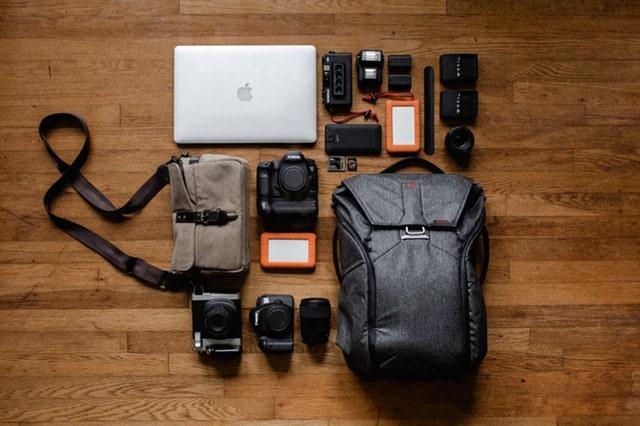The social media images you post online convey more information than you realize. Studies have found that 93% of all human communication is visual and the brain processes images 60,000 times faster than it does text.
Think about how an infant recognizes its mom or demands a bottle before it can even form those words.
This means that before your customers even read any of your social media posts, they are collecting information and forming opinions based on the colors, lighting, fonts and other visual cues. The right images can pique the interest of your customers and lure them in.
Meanwhile, the wrong social media images will get glossed over as your customers look for more engaging content.
Related: How to optimize images for the web
10 tips for creating share-worthy social media images
This guide will help you develop social media images that attract customers. It will look at how aspects like lighting and color cause reactions in your customers. All in all, we’ll cover the following tips for creating great social media pictures:
- Practice makes perfect.
- Be thoughtful.
- Create a signature style.
- Crop images instead of zooming.
- Use natural lighting.
- Vary your social media images.
- Invest in the right equipment.
- Brand your social media images.
- Edit your photos.
- Tell a story.
Keep reading as we discuss the top 10 tips to create engaging social media pictures for your brand.
1. Practice makes perfect
The key to creating great social media images is naturally the image. However, you can’t expect to create amazing images from the start — it takes time.
The greatest photographers of our time didn’t start out working at National Geographic or shooting the cover of Vogue.
You can’t expect to be an expert in creating social media images overnight.
However, the more you experiment with your camera and try new things, the likelier you are to learn how to quickly get a good shot. Photography, even amateur photography through the use of a smartphone, is a learned skill not unlike driving or drawing.
If you want to improve your photography skills outside of your social media presence (or for your social media presence) look for opportunities to use them.
Volunteer with a local nonprofit and offer to shoot an event or the board’s professional headshots.
Join a photography club that goes on creative walks on the weekends. You can even look into signing up for a class at the nearby college.
Social media management is a process. It is entirely possible that in a year or two you will look back at your old social media images and feel surprised at how advanced you have become from when you first started out.
2. Be thoughtful
As you start out creating images for social media, there are two aspects of photography to consider. There is the actual setup of the camera, including the shutter speed, f-stop and ISO, and there is the visual composition of the image you choose to create.
There are a handful of composition rules that photographers follow when they set up a piece. While these rules are meant to be broken, they can help you when you are just starting out. A few of these include:
- The Rule of Thirds — If your image is divided into nine even sections, place the subject along the lines, slightly off to the center. This creates movement and draws in the eye. (You can see an example of this in the image below.)
- Balancing Elements — If you use the Rule of Thirds, then your image may feel off-balance. Add other elements to the other side of the photo to make the content feel more stable.
- Leading Lines — Use natural lines to tell the eye where to go.
- Viewpoint — Look for a unique viewpoint that another photographer has yet to catch.

You can follow these rules even if you only use your smartphone. Consider the lines, lighting, and content of the image in a thoughtful way to draw audiences in.
3. Create a signature style
Creating a signature style is important for attracting new followers with your social media images. If you are trying to build your social media channels, your style can immediately convey who you are and why people should follow you.
Look at your internal values and the visual presentation you want to share with the world. What makes your brand unique?
You may even want to develop a style guide for your social media channels so you never forget your roots. This will cover the tone that you plan to use with your content and why you chose the signature style that you did.
If you share the content of others or have guest posts on your social pages, you can make sure that these additions match your style.
Related: Everything you need to know about creating a brand style guide
4. Crop images instead of zooming

Zooming is exceptionally easy when you first start out with photography. You feel like you can crop your image within the lens and save time on editing. However, you may discover that zoomed-in images lack the quality you need.
Zooming can reduce the clarity in your image – especially if you are capturing images on a phone camera.
As a rule of thumb, the best zoom feature for you to use is your two feet. If possible, walk closer to your image to get the picture you want without utilizing a zoom lens.
As an alternative to zooming, use the crop feature to create the ideal images you want. Cropping instead of zooming allows you to focus on the other aspects of photography.
You can improve your shutter speed or adjust the depth of field without worrying about changes in lighting because of the zoom lens. Then, you can create the image you really want through cropping once you start editing the content.
Related: Social media image sizes: The 2020 cheat sheet
5. Use natural lighting
You don’t need to be an expert photographer to significantly improve the quality of your social media images. If there’s one top tip you take from this list, it’s to use natural lighting as much as possible.
Natural lighting creates a softer experience than using the flash does.
It gives life to the subject of your social media pictures and provides detail without highlighting the subject’s flaws. This is particularly relevant if you are using your smartphone to capture social media images. The lighting won’t look as professional with a smartphone camera as it would in a studio.
If you’re on the fence about your lighting options, try taking photos in a few different ways. Compare the same photo with flash and without to see which one you like more.
Using flash in moderation also applies to more advanced cameras. Adjusting the shutter speed or ISO could create the same look that you want with natural light without setting up your flash.
Plus, if your subject is human, you are less likely to catch them in a squint because the flash blinded them during the shot.
6. Vary your social media images
While you want to create content that matches your brand’s identity, you can still appeal to new audiences by varying your images. There are multiple photographic options that you can use when sharing content on your social media channels.
Consider testing a few of these options:
- Candid images — These are photos captured without the subject knowing. Examples of this include a food blogger capturing a moment of bliss at the subject trying a new recipe or a travel blogger photographing a moment of wonder.
- User-generated images — If you need help creating content, ask your audience to share images with you. They can create content related to your brand for you to share.
- Behind-the-scenes images — People love to see what goes into creating an image or a business. Share photos of your company, workspace, or even the less glamorous moments of your brand – like waiting at the airport during a flight delay – to add a human element to your content.
- Personal images — If all of your content is focused on your brand, consider adding some personal content to paint a picture of the person behind the company or name.
Get creative with your account. Test new image ideas and see what your audiences love – and what your audience ignores.
Related: 11 places to find more diverse stock photos of people
7. Invest in the right equipment

As you start to create more advanced social media pictures, invest in additional equipment to improve the process. If you want to make the most of your investment, wait until you discover a need for an accessory before you buy it.
For example, you may discover that you need a tripod to balance your shot but don’t need a flash attachment as much as you thought.
Even if you’re just shooting from your smartphone, you can still invest in equipment to make your photos look more professional. Many social media influencers rely on photography equipment to help create smartphone photos that are incredibly shareable online.
See what’s currently on the market and decide which gadgets and tools can really help you.
8. Brand your social media images
Branding is an important part of social media. Your branded content allows people to tie certain images back to your name and associate content with who you are.
Remember how the brain processes images faster than text? With the right branding, your followers can immediately associate an image with your name without even checking to see that your account posted it.
Branding comes in various forms.
Some social media channels make sure their logo or watermark is added on every post. The goal is to prevent other accounts from stealing the content. Other accounts use branding in more subtle ways.
Your branding could show through in the filters you choose, the colors you add, or the composition of your content.
To get an idea for branding, select a few social media accounts that you admire and look at their images on a macro level. Look at their main Instagram page and see all of their photos lined up together.
How are they unified? How does each photo reflect the account that shared it? This can give you ideas for developing your own brand fingerprints.
Related: How to use Canva to create branded images in less than an hour
9. Edit your photos
Editing your social media images will ensure that they meet the right dimensions for the social media channels that you post on. Editing your photos will prevent you from scrambling to resize the images as you share them and can help you catch any problems beforehand.
As you edit your photos, also check for unwanted blemishes or problems, like an underexposed subject, that you will want to fix before you share.
You have multiple options for editing software depending on your level of experience and investment. Adobe Lightroom is commonly used by photographers. You can also use Adobe Photoshop to adjust your images to match your brand.
These products are significantly more advanced than the other options out there, and you may want to take a class on photo editing through a nearby college or community center.
On a smaller scale, many smartphones have built-in editing tools and there are apps online that you can download for photo editing. This could be a good place to start if you’re just getting into visual branding for social media.
Related: 10 best practices for picture editing
10. Tell a story

If the old adage that “a picture says a thousand words” seems like a cliché, it’s only because the statement is true. Even small cues in body language and facial expressions can convey a significant amount of information to whoever looks at a shot.
You have the power to capture this information in your photography and share it across social media.
Look at your images and consider how they would be viewed out of context. If your audience never read the caption you provided or knew nothing about your brand, how would they feel about it? What information would they glean?
Your social media images can tell a story and give customers all of the information they need before they even read what you have to say.
Plus, your audience follows your social media channel for stories. People use social media to be entertained.
Even if you invest in social channels to sell your products, you can sell a certain lifestyle or tell stories with the items you promote. Your customers will tune in for a good tale.
Invest in visual content to grow your social media presence
Social media is exceptionally visual. From your Instagram feed to the videos you share on Facebook, your customers want to look and watch before they read. If you want to catch the eye of your target audience, take time to develop your visual content.
Follow the tips above to improve your images and develop a brand that stands out while pleasing the eye.
Editor’s note: When you sign up with GoDaddy Social, we’ll provide you with a professional photoshoot to help tell the story of your business through beautiful visuals. We’ll use the photos across your social media sites and email marketing to capture your unique brand and make your online presence unforgettable.
This article includes content originally published on the GoDaddy blog by Amanda Rodriguez.







